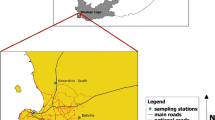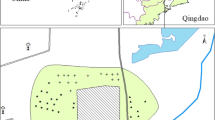Abstract
Emerging contaminants is a topic that has been in evidence, especially in the last decades. These compounds are pesticides, pharmaceuticals, and personal care products that are present in several locations, mainly in large urban centers. The aim of this work was to investigate the fate of seven compounds (atrazine, simazine, ametrine, tebuthiuron, 2,4-D, fipronil, and diclofenac) using leaching column experiments to evaluate accumulation and transfer in 5 different types of urban soils from Porto Alegre, Southern Brazil. Chemical analyses were carried out through liquid chromatography tandem mass spectrometry (LC-MS/MS). The results showed that the soil derived from quaternary sediments, with well-sorted sandy sediments, was the one in which the contaminants had higher mobility. This soil also has a pH above the average of the others in the city, a factor that may also be responsible for less retention of substances. Tebuthiuron is the substance with the greatest leaching potential overall. Column experiments are a relevant tool to understand the behavior of emerging contaminants in soils and implications on the population health.
Similar content being viewed by others
Availability of data and materials
All data generated or analyzed during this study are included in this published article.
References
Amarante, O. P., Brito, N. M., Santos, T. C. R., Nunes, G. S., & Ribeiro, M. L. (2003). Determination of 2,4-dichlorophenoxyacetic acid and its major transformation product in soil samples by liquid chromatographic analysis. Talanta, 60, 115–121.
Banzhaf, S., & Hebig, K. H. (2016). Use of column experiments to investigate the fate of organic micropollutants—a review. Hydrology and Earth System Sciences, 20, 3719–3737.
Bertelkamp, C., Reungoat, J., Cornelissen, E. R., Singhal, N., Reynisson, J., Cabo, A. J., ... & Verliefde, A. R. (2014). Sorption and biodegradation of organic micropollutants during river bank filtration: A laboratory column study. Water research, 52, 231-241.
Burke, V., Duennbier, U., & Massmann, G. (2013). The effect of aeration on the removal of wastewater-derived pharmaceutical residues from groundwater—a laboratory study. Water Science and Technology, 67, 658–666.
Burke, V., Greskowiak, J., Asmuß, T., Bremermann, R., Taute, T., & Massmann, G. (2014). Temperature dependent redox zonation and attenuation of wastewater-derived organic micropollutants in the hyporheic zone. Science of the Total Environment, 482, 53–61.
Dousset, S., Chauvin, C., Durlet, P., & Thévenot, M. (2004). Transfer of hexazinone and glyphosate through undisturbed soil columns in soils under Christmas tree cultivation. Chemosphere, 57, 265-272.
Gustafson, D. I. (1989). Groundwater ubiquity score: a simple method for assessing pesticide leachability. Environmental Toxicology and Chemistry: An International Journal, 8, 339–357.
Hasenack, H. (2008). Diagnóstico Ambiental de Porto Alegre: geologia, solos, drenagem, vegetação/ocupação e paisagem. Secretaria Municipal do Meio Ambiente
Hebig, K. H., Groza, L. G., Sabourin, M. J., Scheytt, T. J., & Ptacek, C. J. (2017). Transport behavior of the pharmaceutical compounds carbamazepine, sulfamethoxazole, gemfibrozil, ibuprofen, and naproxen, and the lifestyle drug caffeine, in saturated laboratory columns. Science of The Total Environment, 590, 708-719.
IUPAC, International Union of Pure and Applied Chemistry, Pesticide Properties Data Base PPDB), http://sitem.herts.ac.uk/aeru/iupac/ Accessed 8 March 2019).
Kolpin, D. W., Furlong, E. T., Meyer, M. T., Thurman, E. M., Zaugg, S. D., Barber, L. B., & Buxton, H. T. (2002). Pharmaceuticals, hormones, and other organic wastewater contaminants in US streams, 1999–2000: a national reconnaissance. Environmental Science & Technology, 366, 1202–1211.
Kümmerer, K. (2009). Antibiotics in the aquatic environment–a review–part I. Chemosphere, 75, 417-434
Mersmann, P., Scheytt, T., & Heberer, T. (2002). Column experiments on the transport behavior of pharmaceutically active compounds in the saturated zone. Acta hydrochimica et hydrobiologica, 30, 275–284.
Montagner, C. C., Vidal, C., & Acayaba, R. D. (2017). Contaminantes emergentes em matrizes aquáticas do Brasil: cenário atual e aspectos analíticos, ecotoxicológicos e regulatórios. Química nova, 40, 1094–1110.
Montagner, C. C., Vidal, C., Acayaba, R. D., Jardim, W. F., Jardim, I. C., & Umbuzeiro, G. A. (2014). Trace analysis of pesticides and an assessment of their occurrence in surface and drinking waters from the State of São Paulo Brazil. Analytical Methods, 617, 6668–6677.
Müller, B., Scheytt, T., & Grützmacher, G. (2013). Transport of primidone, carbamazepine, and sulfamethoxazole in thermally treated sediments—laboratory column experiments. Journal of Soils and Sediments, 13, 953–965.
Murray, K. E., Thomas, S. M., & Bodour, A. A. (2010). Prioritizing research for trace pollutants and emerging contaminants in the freshwater environment. Environmental Pollution, 158, 3462–3471.
NIH, National Library of Medicine, PubChem, https://pubchem.ncbi.nlm.nih.gov/ (Accessed 8 March 2019).
Oliveira Júnior, R. S., & Regitano, J. B. (2009). Dinâmica de pesticidas no solo. Química e mineralogia do solo. Viçosa: Sociedade Brasileira de Ciência do Solo, 187-248.
Petrie, B., Barden, R., & Kasprzyk-Hordern, B. (2015). A review on emerging contaminants in wastewaters and the environment: current knowledge, understudied areas and recommendations for future monitoring. Water Research, 72, 3–27.
Petrovic, M., Radjenovic, J., Postigo, C., Kuster, M., Farre, M., de Alda, M. L., Barceló, D. (2008). Emerging contaminants in waste waters: sources and occurrence, In: Emerging contaminants from industrial and municipal waste. Springer. Berlin, pp. 1–35.
Philipp, R. P., Machado, R., Nardi, L. V. S., & Lafon, J. M. (2008). O magmatismo granítico Neoproterozóico do Batólito Pelotas no sul do Brasil: novos dados e revisão da geocronologia regional. Brazilian Journal of Geology, 32(2), 277-290.
Philipp, R. P., & de Campos, R. S. (2004). Geologia, petrografia e litogeoquímica dos Gnaisses Porto Alegre, RS, Brasil: implicações geotectônicas. Pesquisas em Geociências, 31, 79–94.
Philipp, R. P., Pimentel, M. M., & Chemale, F., Jr. (2016). Tectonic evolution of the Dom Feliciano Belt in Southern Brazil: geological relationships and U-Pb geochronology. Brazilian Journal of Geology, 46, 83–104.
Richardson, S. D., & Ternes, T. A. (2018). Water analysis: emerging contaminants and current issues. Analytical Chemistry, 90, 398–428.
Rivera-Utrilla, J., Sánchez-Polo, M., Ferro-García, M. Á., Prados-Joya, G., & Ocampo-Pérez, R. (2013). Pharmaceuticals as emerging contaminants and their removal from water. A review. Chemosphere, 93, 1268–1287.
Roisenberg, C., Viero, A. P., Roisenberg, A., Schwarzbach, M. S., & Morante, I. C. (2003). Caracterização geoquímica e gênese dos principais íons das águas Subterrâneas de Porto Alegre, RS. Revista Brasileira de Recursos Hídricos, 8, 137-147.
Salvia, M. V., Experton, J., Geandel, C., Cren-Olivé, C., & Vulliet, E. (2014). Fate of pharmaceutical compounds and steroid hormones in soil: study of transfer and degradation in soil columns. Environmental Science and Pollution Research, 21, 10525–10535.
Scheytt, T. J., Mersmann, P., & Heberer, T. (2006). Mobility of pharmaceuticals carbamazepine, diclofenac, ibuprofen, and propyphenazone in miscible displacement experiments. Journal of Contaminant Hydrology, 83, 53-69.
Schriks, M., Heringa, M. B., van der Kooi, M. M., de Voogt, P., & van Wezel, A. P. (2010). Toxicological relevance of emerging contaminants for drinking water quality. Water Research, 44, 461–476.
Siemens, J., Huschek, G., Walshe, G., Siebe, C., Kasteel, R., Wulf, S., & Kaupenjohann, M. (2010). Transport of pharmaceuticals in columns of a wastewater irrigated Mexican clay soil. Journal of Environmental Quality, 39, 1201–1210.
Silva, G. M. S., & Pinheiro, R. (2005). Análise da automedicação no município de Vassouras–RJ. Infarma, 17, 59–62.
Tetzner, N. F., Maniero, M. G., Rodrigues-Silva, C., & Rath, S. (2016). On-line solid phase extraction-ultra high-performance liquid chromatography-tandem mass spectrometry as a powerful technique for the determination of sulfonamide residues in soils. Journal of Chromatography A, 1452, 89–97.
Terzić, S., Senta, I., Ahel, M., Gros, M., Petrović, M., Barcelo, D., & Jovančić, P. (2008). Occurrence and fate of emerging wastewater contaminants in Western Balkan Region. Science of the Total Environment, 399, 66–77.
Tomazelli, L. J., & Villwock, J. A. (2005). Mapeamento geológico de planícies costeiras: o exemplo da costa do Rio Grande do Sul. Gravel, 3, 109-115.
Unold, M., Kasteel, R., Groeneweg, J., & Vereecken, H. (2009). Transport and transformation of sulfadiazine in soil columns packed with a silty loam and a loamy sand. Journal of Contaminant Hydrology, 103, 38–47.
Funding
The study is financially supported by the Fundação de Amparo à Pesquisa do Estado de São Paulo (FAPESP 2015/18790-3) and Conselho Nacional de Desenvolvimento Científico e Tecnológico (CNPq).
Author information
Authors and Affiliations
Contributions
All authors contributed to the study conception and design. Material preparation, soil column experiment setups, and field data collection were performed by Paulo Henrique Prado Stefano, Ari Roisenberg, and Elias Bittencourt Gomes. The chemical analyses were performed by Cassiana Carolina Montagner and Bianca Veloso Goulart. The first draft of the manuscript was written by Paulo Henrique Prado Stefano, and all authors commented on previous versions of the manuscript. All authors read and approved the final manuscript.
Corresponding author
Ethics declarations
Competing interests
The authors declare no competing interests.
Additional information
Publisher's Note
Springer Nature remains neutral with regard to jurisdictional claims in published maps and institutional affiliations.
Rights and permissions
About this article
Cite this article
Stefano, P.H.P., Roisenberg, A., Gomes, E.B. et al. Transport of emerging contaminants: a column experimental study in granitic, gneissic, and quaternary alluvial soils from Porto Alegre, Southern Brazil. Environ Monit Assess 193, 262 (2021). https://doi.org/10.1007/s10661-021-09026-w
Received:
Accepted:
Published:
DOI: https://doi.org/10.1007/s10661-021-09026-w







